SWPanel allows you to easily manage the DNS records associated with your service. To begin, access the dashboard of the service for which you need to manage DNS records. Enter the name of the service in the search field at the top and click:
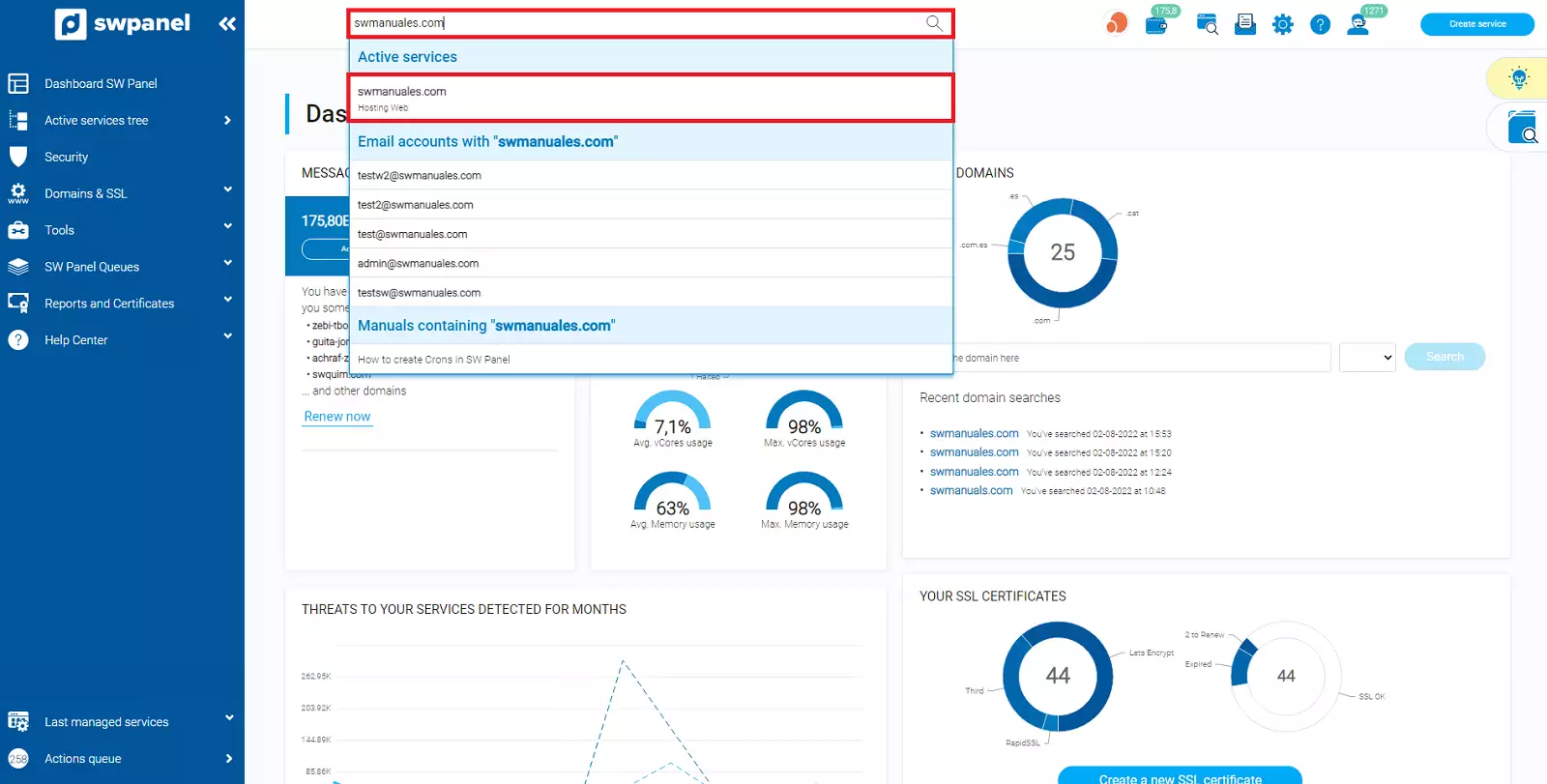
Next, go to Service management > DNS management (left menu):
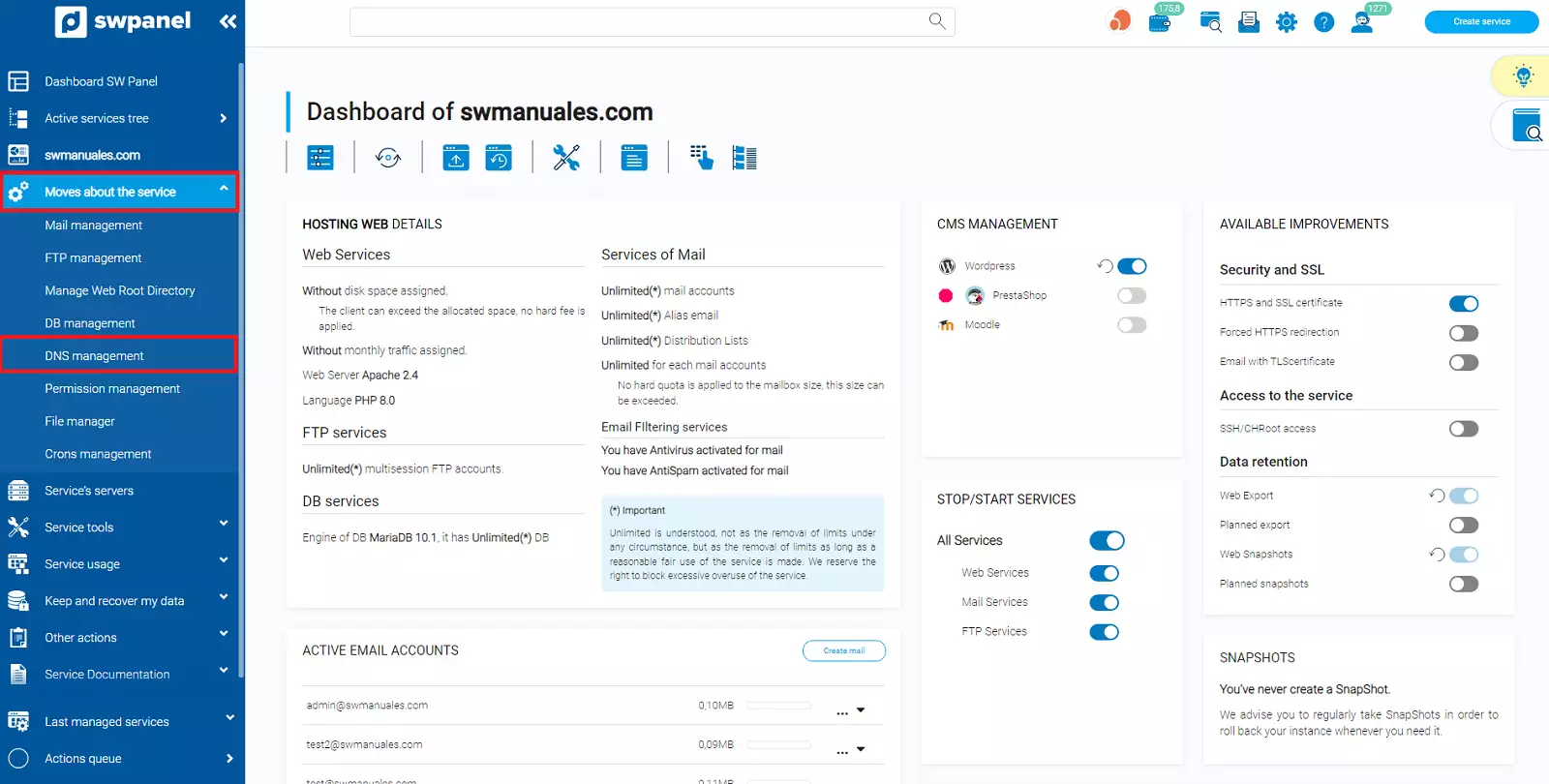
The records currently created in the DNS zone will be displayed. From this section you will be able to:
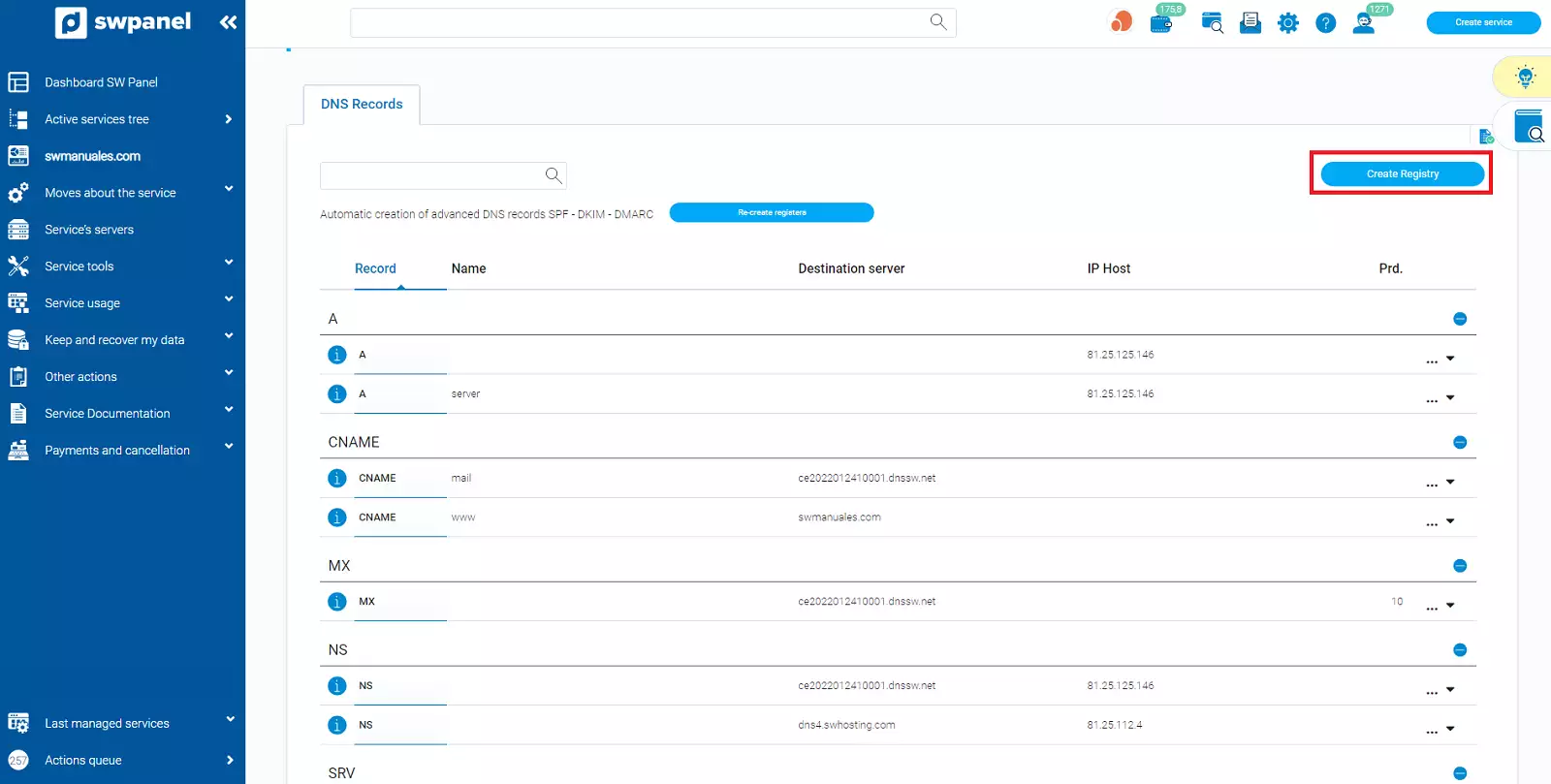
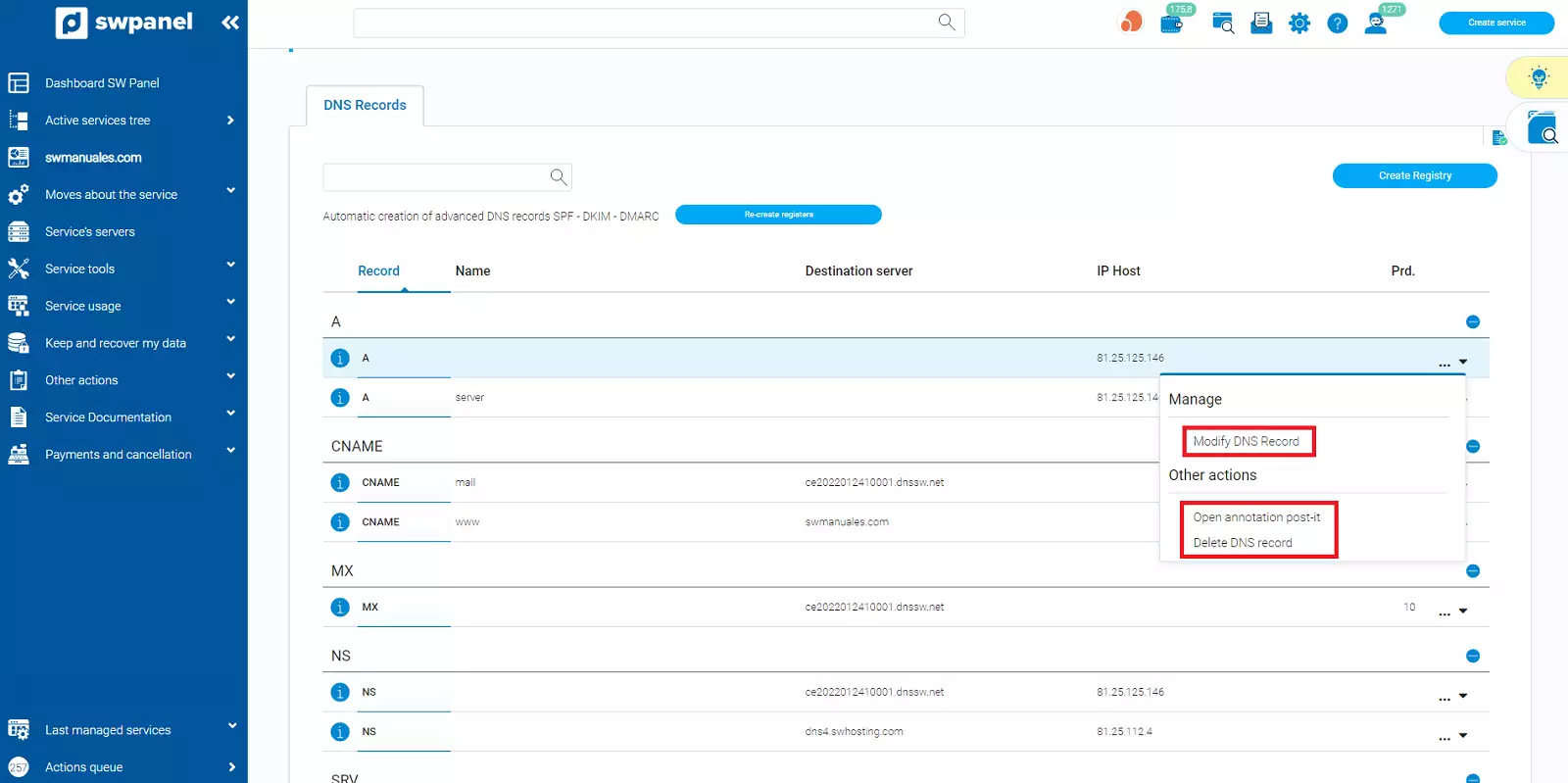
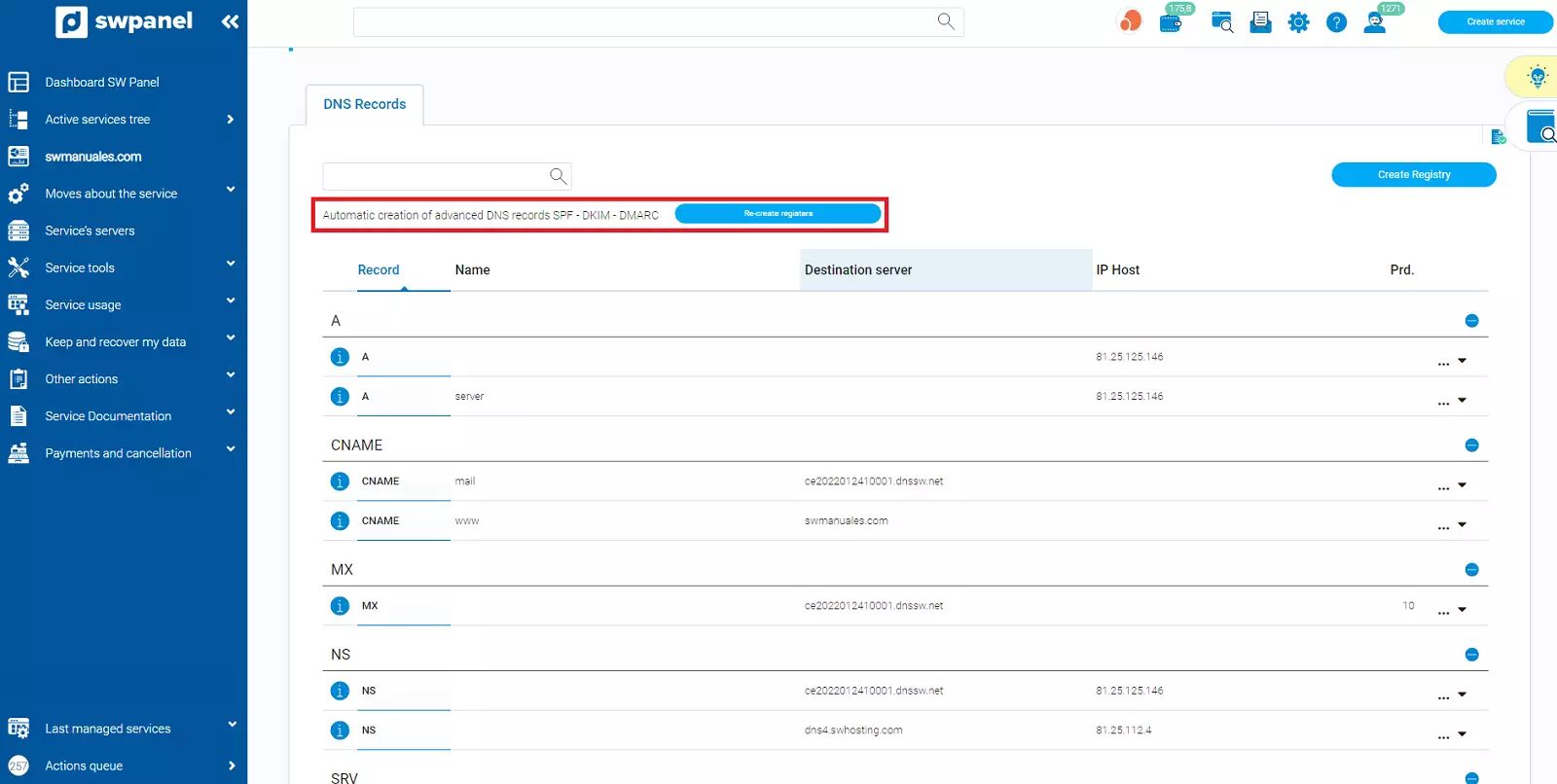
Records are usually generated automatically. If they are already created in your service, the record creation button will be blue and if they are not created, the button will be green.
info Note: DNS record modifications can take up to 48 hours to propagate globally.
We explain how to create each of the records. In the following examples, we will create them in the DNS zone of "swmanuales.com"
Associates a domain with an IP address.
Click on Create Record (blue button on the right).
In the drop-down Registration Type select Registration A (Host):
Click Create Record.
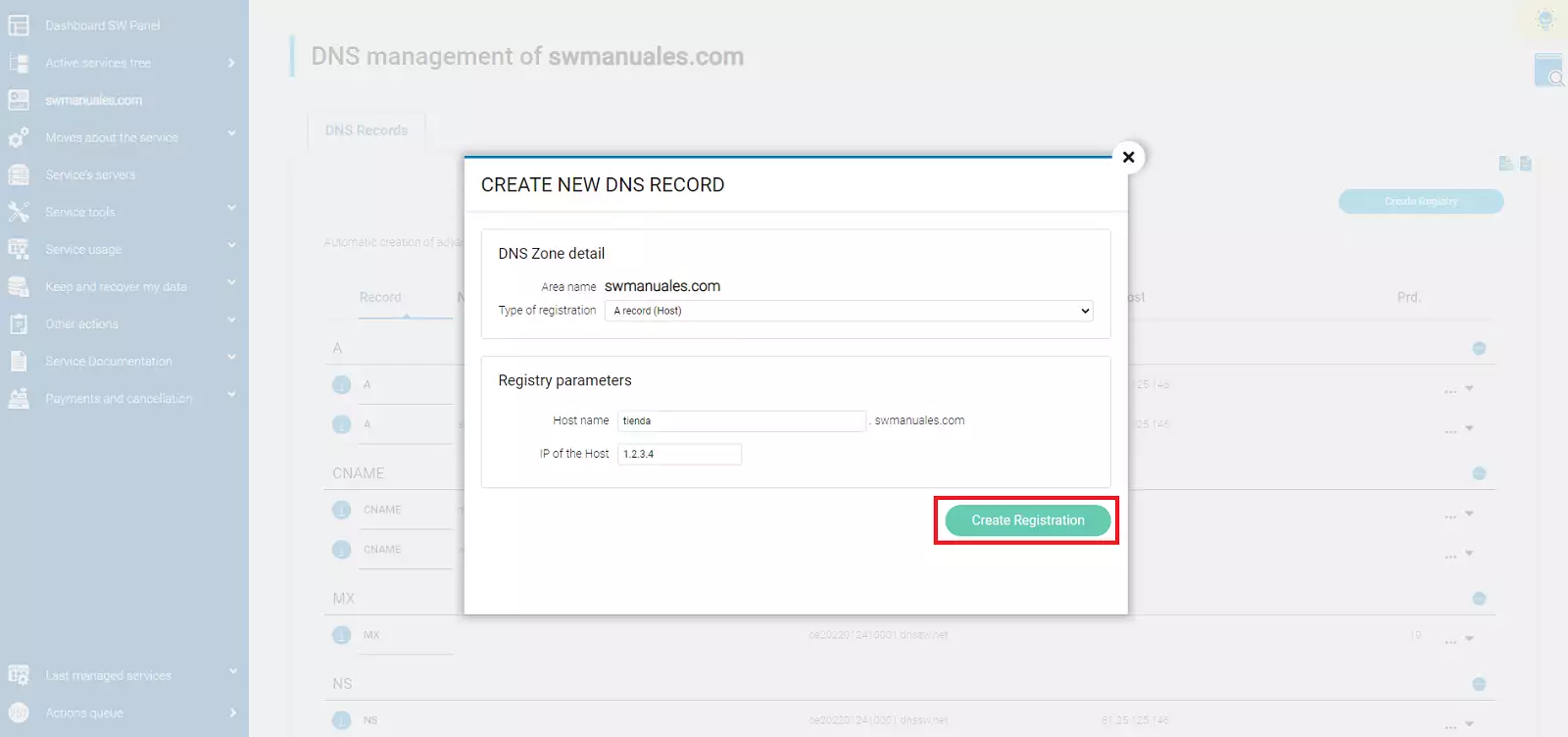
Result: The domain "store.domainsw.com" will resolve to IP "1.2.3.4".
Create an alias equivalent to another domain.
Click on Create Record (blue button on the right).
In the drop-down Record Type select CNAME Record (Alias):
Click Create Record.
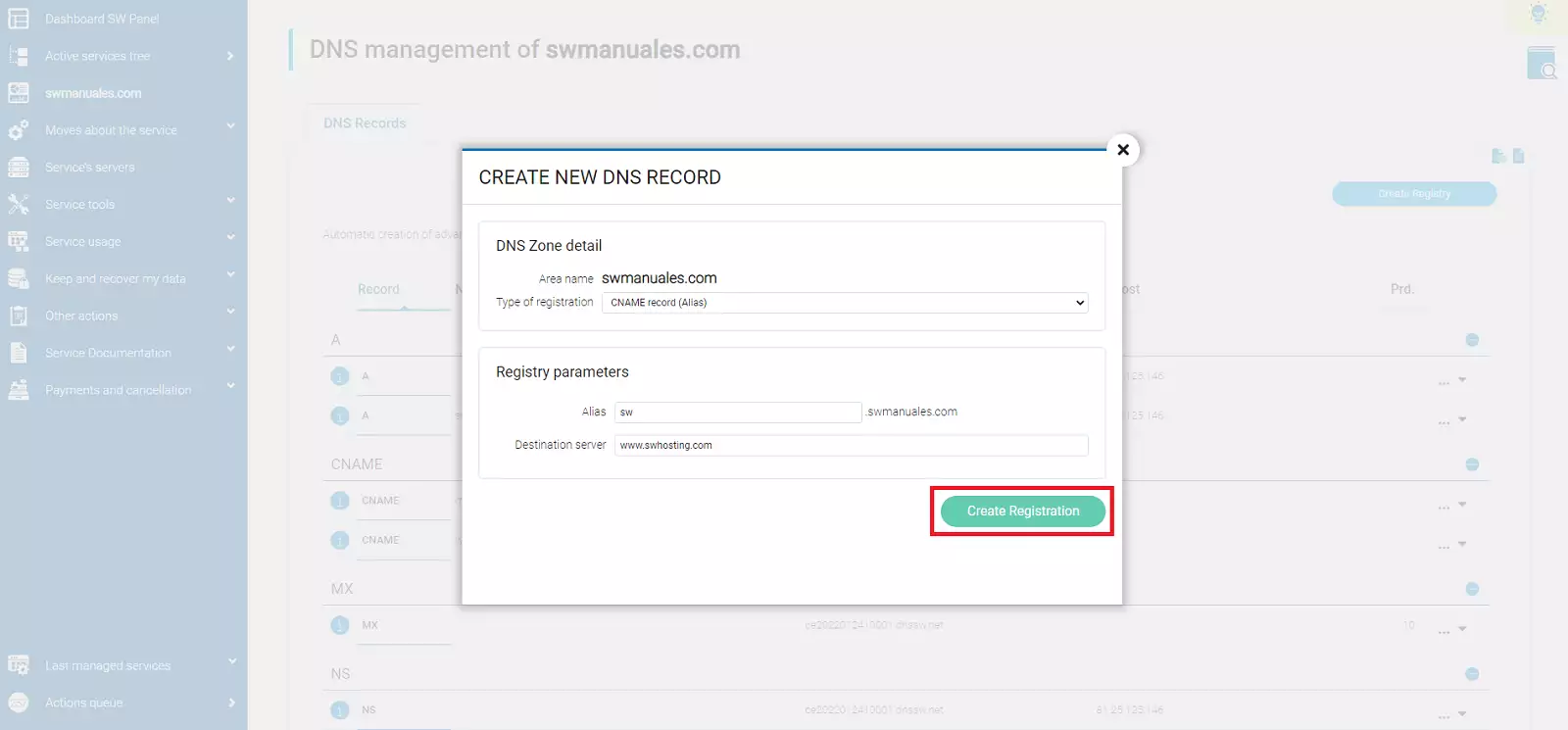
Result: The domain "sw.domainsw.com", will resolve to the same IP that resolves to the domain "www.swhosting.com".
An informative record, responsible for indicating which DNS servers contain the domain records. SWPanel is in charge of generating these records. Create and/or modify these records if it is really necessary and you know what you are doing.
Click on Create Record (blue button on the right).
In the Registry Type drop-down menu, select NS (DNS) Registry:
Click Create Record.
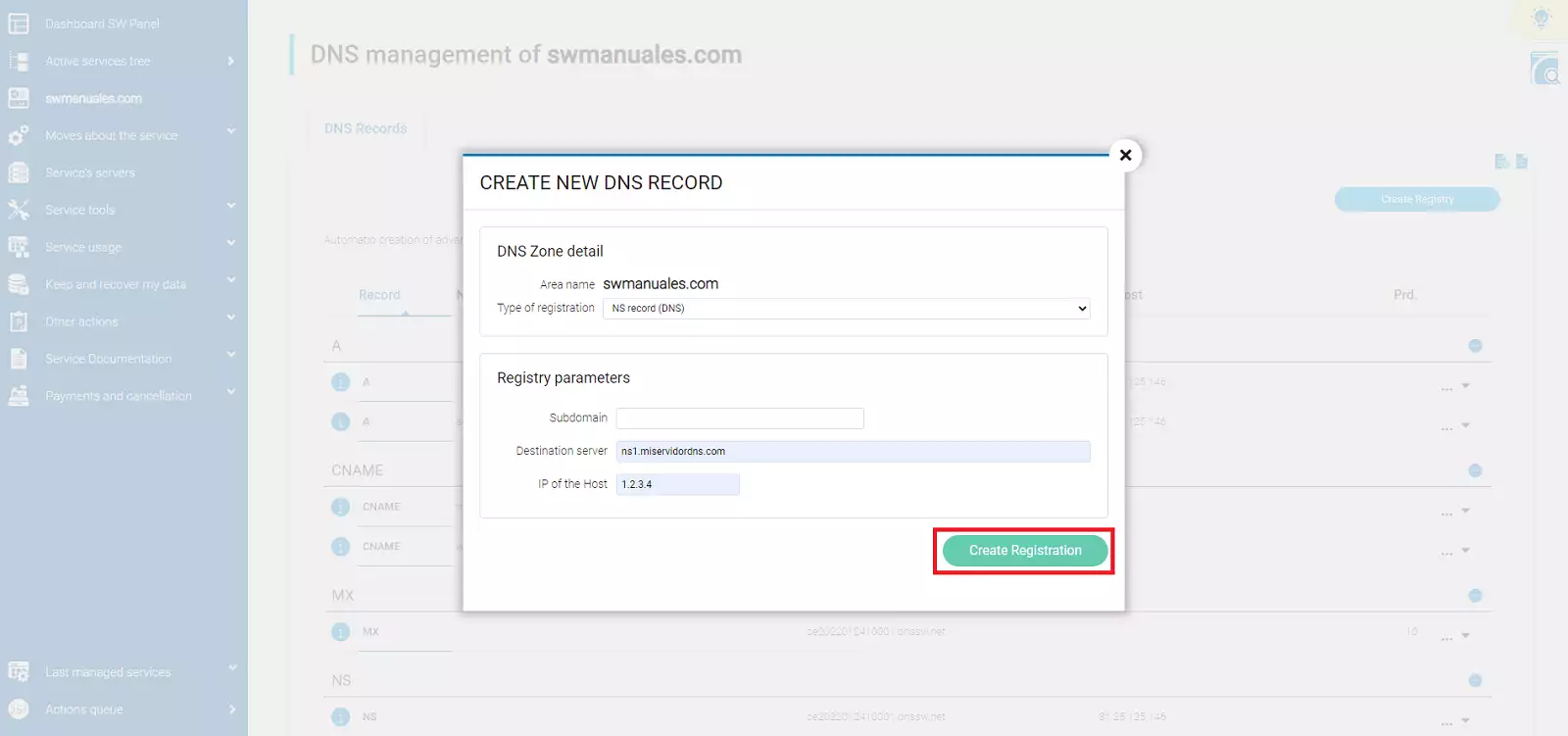
Result: We are telling the world that the server "ns1.miservidordns.com" (with IP 1.2.3.4), is the one who has the valid DNS information for the domain or subdomain (it is the authoritative server).
Assign mail servers.
Click on Create Registry (blue button on the right).
In the drop-down Type of record select MX Record (Mail Exchanger):
Click Create Record.
info Important: The mail server field must be a name, it cannot be an IP. Also, the domain name that you put as mail server must be created as an "A" record, it cannot be a "CNAME" in the DNS server that resolves it. This is because the mail servers will make two DNS resolutions to send an email to a domain on another server, the first one to know the MX record and the second one to find out its IP.
Result: The e-mail addressed to the current domain ("domainsw.com"), will be received and managed by the mail server "mail.correosw.com".
It indicates who can send an email from a given domain in order to protect against sender spoofing. It is common that in order to prevent fraud and spam, large email service providers (such as Google) require the presence of this record. Otherwise, e-mails addressed to them may be rejected or classified as SPAM.
This is a rule that each user must generate independently according to their needs.
info You can use the following services to generate SPF rules: https://www.spfwizard.net/index.php/?lang=en and https://mxtoolbox.com/spf.aspx
Click on Create Record (blue button on the right).
In the drop-down Registry type select SPF Registry (TXT Registry):
Click Create Record.
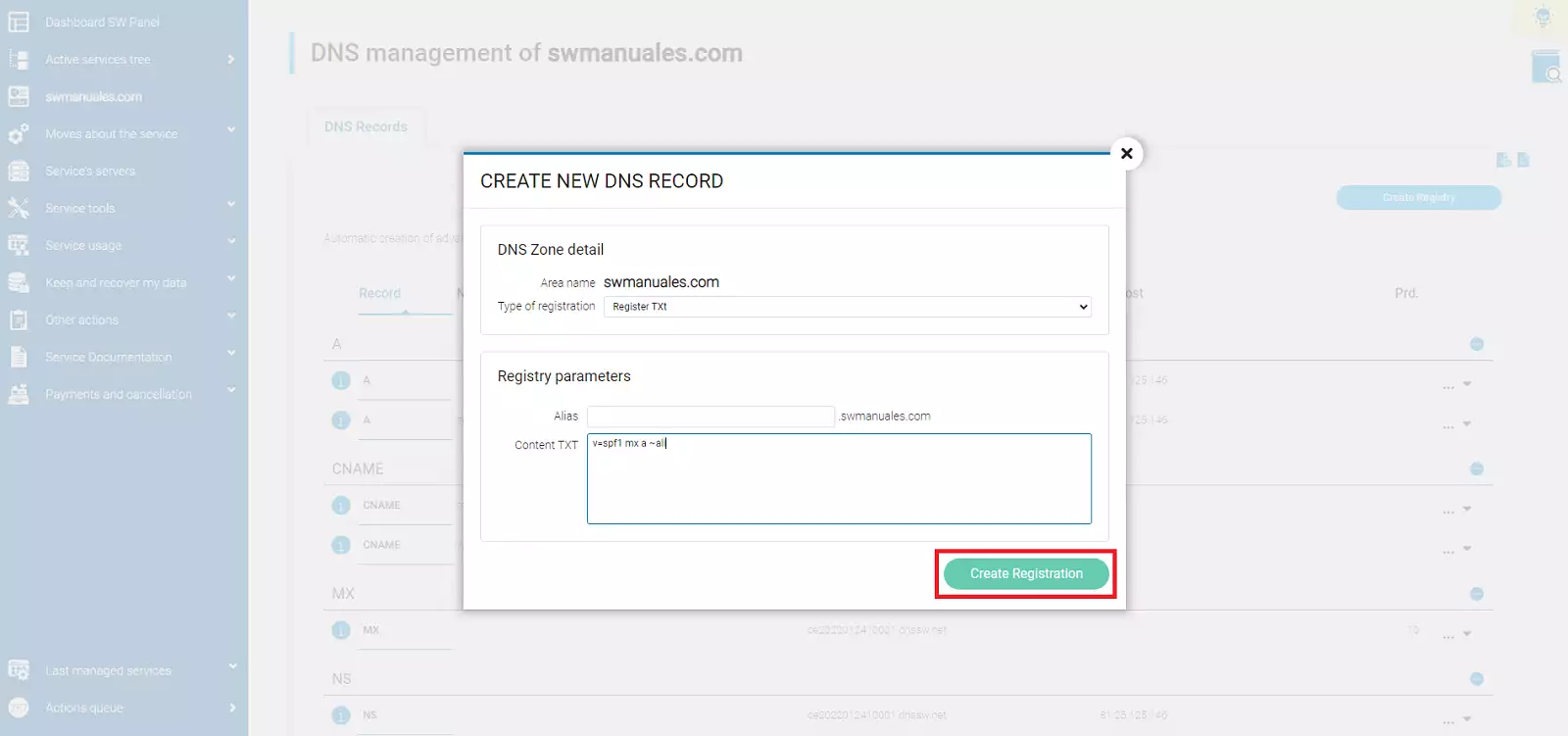
SPF rules are evaluated sequentially from left to right according to the parameters included:
The following prefixes can be used with each of the parameters (with the exception of the first one):
In this case, we have created the following SPF rule:
v=spf1 mx a ~all
v=spf1 mx -all
v=spf1 -mx a ?ip4:1.2.3.4 ~all
This type of record includes a key that allows the recipient of an email to verify that the sender is really who he claims to be. Like SPF and DMARC records, its purpose is to prevent fraud and spam.
As an example, let's create a DKIM record with the following selector and key:
DKIM selector: domainsw
Clave DKIM: v=DKIM1; g=*; k=rsa; p=MIGfMA0GCGGGGGb3DQEBAQUAA4G000BiQKBgQD0000VKvGjmSb4FkI70000e1KqV01eQ70n0000D5bpRfo8ZGcab0000+3+O0mPI7wYblklU0000T0A3LVJk+QTwX00007VA7EiL0utBMW0000iZLJ8Exyzoajql0000RRJmyhngY/0000t0yq21pdlYLrJa0000CfaniL/8gKQGQID0000
Click on Create Record (blue button on the right).
In the drop-down Registry type select TXT Registry:
Click Create Record.
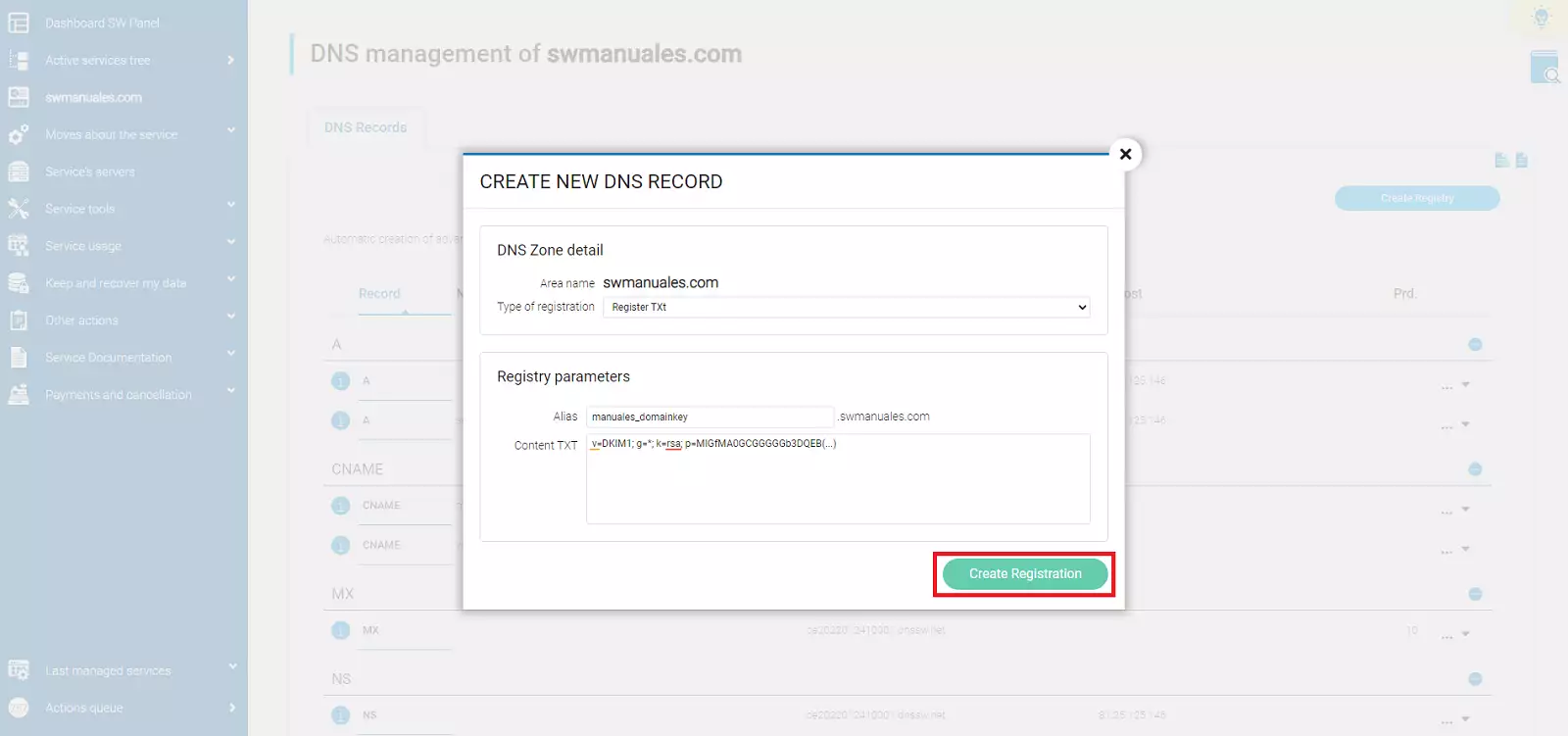
Result: An appropriate TXT record query will respond with the content entered. The recipient of an email will get this key to verify, unequivocally, that the sender is who he claims to be.
info Remember that the use of the DKIM system requires the generation of the key and additional settings in the Cloud.
The DMARC record is a complement to the previous methods (SPF and DKIM) aimed at preventing fraud and spam. It allows to establish:
info You can use the following services to generate DMARC rules: https://dmarcian.com/dmarc-record-wizard/ and https://mxtoolbox.com/DMARCRecordGenerator.aspx
Click on Create Record (blue button on the right).
In the drop-down Registry type select TXT Registry:
Click Create Registry.
info Important: Before creating a DMARC record, you must have SPF and DKIM records created and running.
The DMARC rule parameters allow you to configure its behavior, these are the most basic ones:
In this case, we have created the following DMARC rule:
v=DMARC1; p=none;
v=DMARC1; p=none; sp=reject; rua=mailto:[email protected];
Allows you to publish arbitrary content in your DNS zone, you can enter the data you see fit.
Click on Create Record (blue button on the right).
In the drop-down Record Type select TXT Record:
Click Create Record.
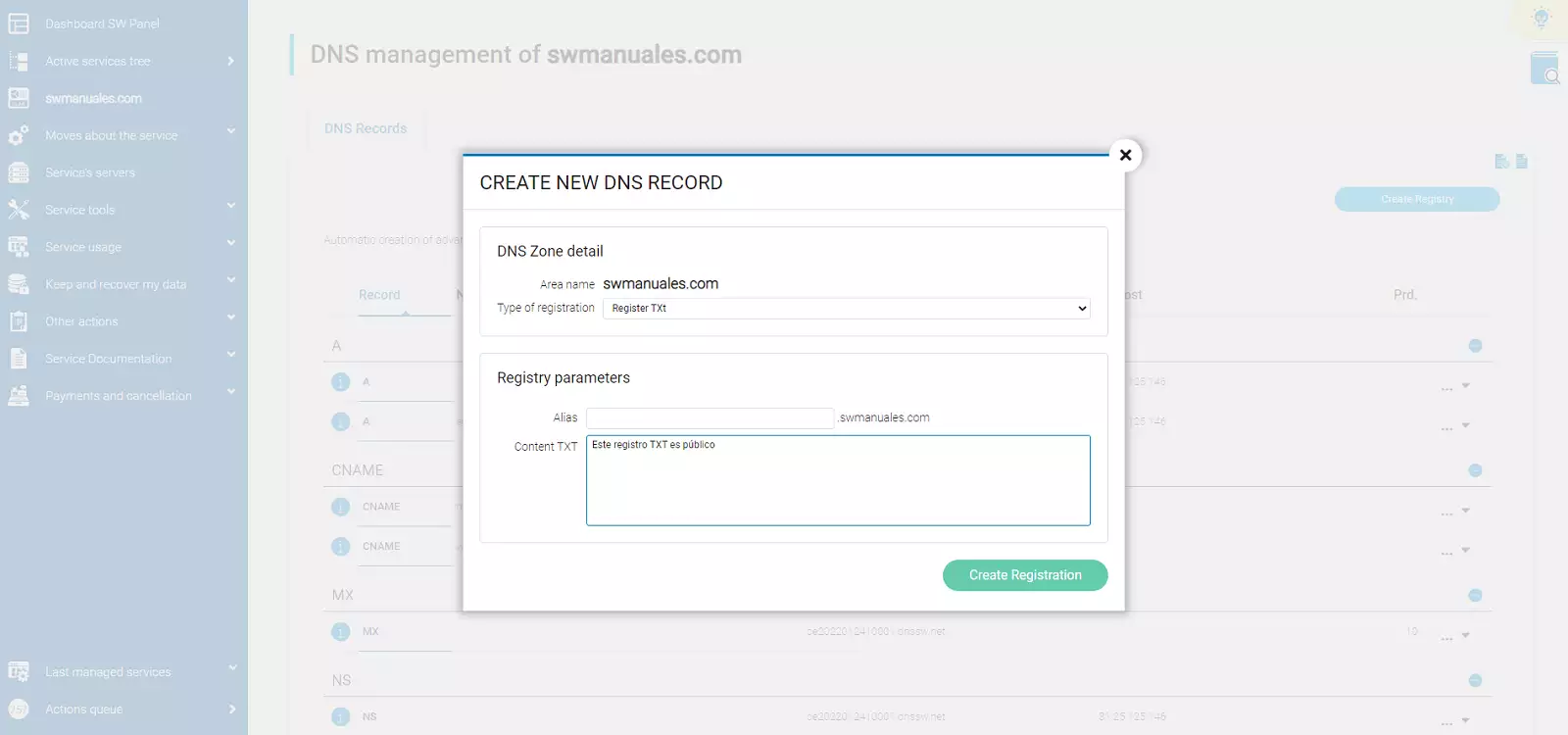
Result: An appropriate TXT record query will respond with the entered content.
Reports the services that are available under your domain. It is generally used in telephony services (SIP), messaging (XMPP) or Office365 among others.
As an example, let's create a record with the following data:
Service: _sip.
Protocol: _tls
Port: 443
Weight: 1
Priority: 100
Name: @
Destination: sipdir.online.dominiosw.com
TTL: 3600
Click on Create Record (blue button on the right).
In the Registration Type drop-down menu, select SRV Registration:
Click Create Record.
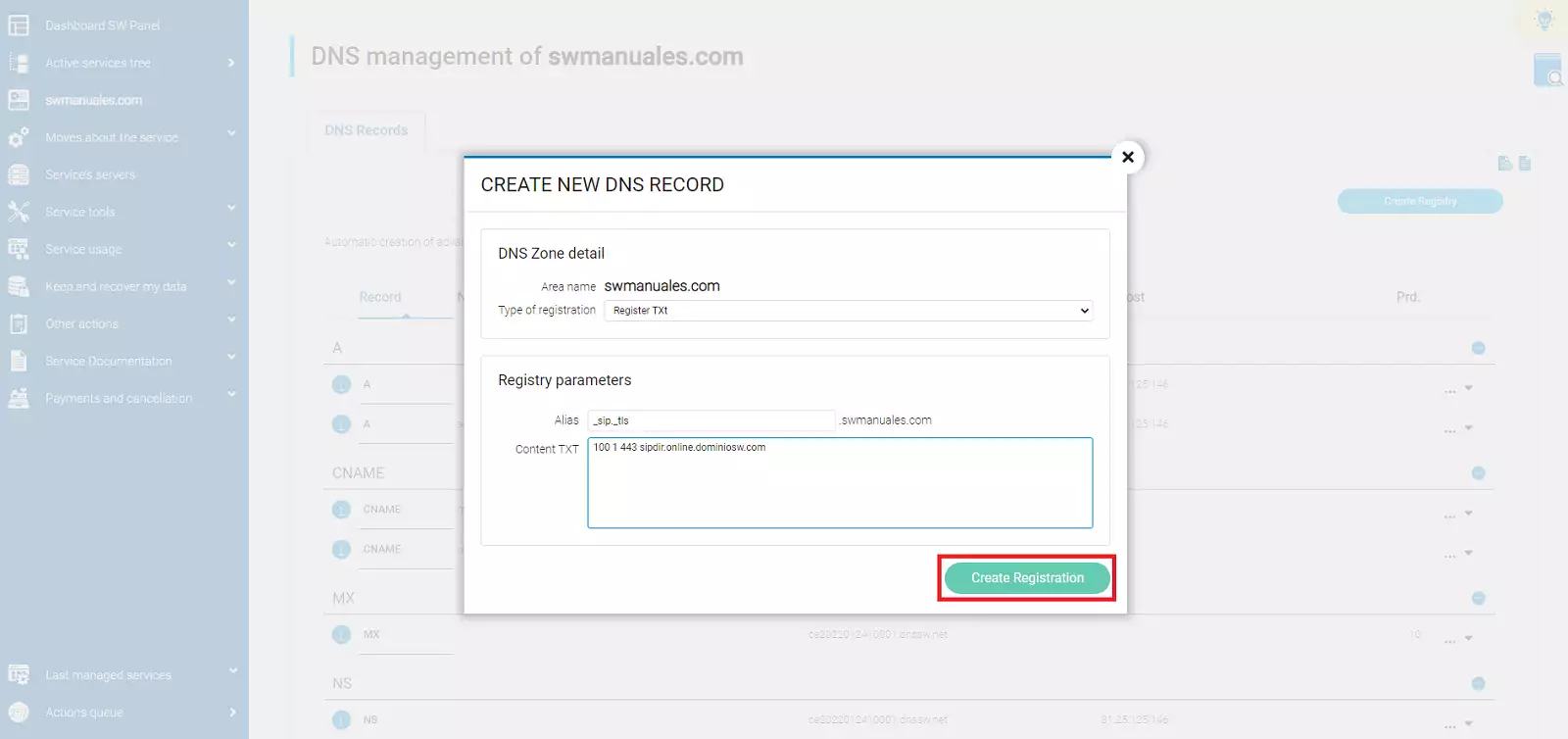
info Important: For this type of registration, it is mandatory to include a period at the end of the TXT content, otherwise your domain name will be automatically added at the end, generating errors and confusion.